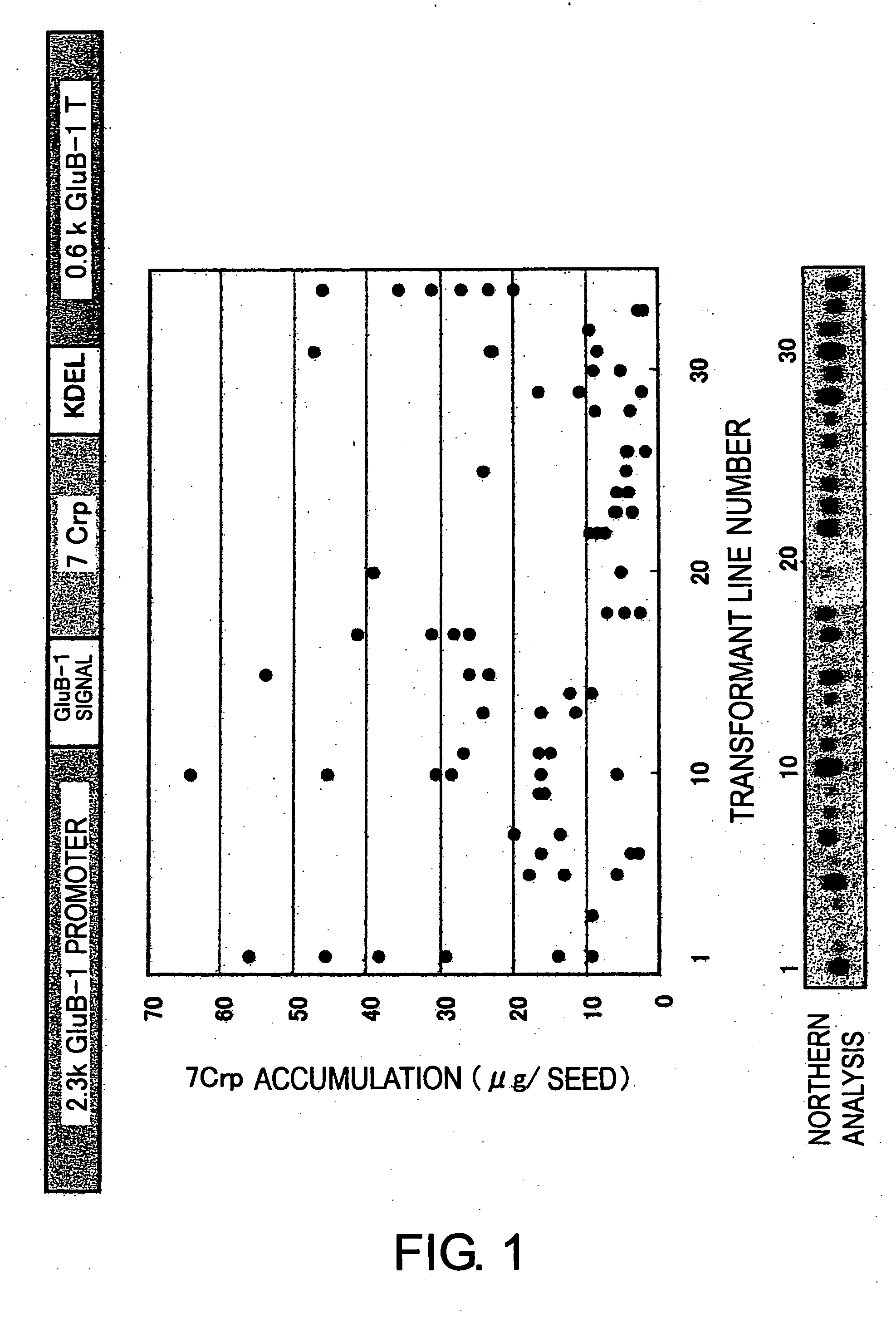Method of accumulating allergen-specific t cell antigen determinant in plant and plant having the antigen determinant accumulated therein
a technology of t cell antigen and accumulative method, which is applied in the field of accumulating an allergen-specific t cell antigen determinant in a plant and having the antigen determinant accumulated therein, can solve the problems of undeveloped actual application form, undeveloped side effects, and anaphylactic shock, and achieves easy yield control, easy to manufacture recombinant peptides, and economic
- Summary
- Abstract
- Description
- Claims
- Application Information
AI Technical Summary
Benefits of technology
Problems solved by technology
Method used
Image
Examples
example 1
Preparation of a T-cell Epitope-Linked Peptide Expression Plasmid and Its Introduction into Rice Kita-Ake
[0142] An expression plasmid for expressing a Japanese cedar pollen allergen T-cell epitope-linked peptide in rice seeds was prepared. After a promoter for the rice seed major protein glutelin GluB-1 (although 1.3 kb promoter had usually been used, the 2.3 kb promoter was used in the present invention; promoter activity being elevated 5-fold or more), a signal sequence, and a T-cell epitope-linked peptide gene were linked, the ER-retention signal KDEL sequence, which has the function to improve the accumulation amount of a foreign gene product in seeds, was added to the 3′-end of the T-cell epitope-linked peptide to produce the expression plasmid pGluBsig7CrpKDEL. The DNA nucleotide sequence used in Examples comprising the 2.3 kb GluB-1 promoter sequence, the glutelin signal sequence, the 7 Crp epitope sequence, the KDEL sequence, and the 0.6 k GluB-1 3′-sequence, is shown in SE...
example 2
Detection of a T-cell Epitope-Linked Peptide in Transformant Seeds
[0145] Total RNA fractions were recovered from seeds at the grain-filling stage of the pGluB7CrpKDEL transformants having no signal sequence, and northern analysis was performed using the T-cell epitope-linked peptide gene as a probe. As a result, transcripts were detected in 27 out of 32 lines, so that accumulation of a T-cell epitope-linked peptide in seeds was expected.
[0146] Therefore, after proteins were extracted from the fully ripened seeds and fractionated by electrophoresis, they were visualized by CBB staining or western blot analysis using a specific antibody. As a result, contrary to expectations, no T-cell epitope-linked peptide signal was detected. The reason for this is probably that, due to lack of the signal sequence, the T-cell epitope-linked peptide localizes not to the rough endoplasmic reticulum but to cytoplasm to be degraded, or, alternatively, is excreted to the outside of cells.
[0147] Next,...
example 3
Detection of a T-cell Epitope-Linked Peptide Gene Introduced into Rice
[0151] In order to detect a T-cell epitope-linked peptide gene introduced into the transformant genome and identify its copy number, analysis of the transformant genomic DNA was performed by Southern blot technique. Among transformants thus obtained, genomic DNA was prepared from leaves of transformant lines showing high level of T-cell epitope-linked peptide expression, and, after treatment with the restriction enzyme Sac I, Southern blot analysis was carried out using a whole region of the T-cell epitope-linked peptide gene as a probe. Since the plasmid used in the transformation is cleaved by Sac I only at one site, the number of bands detected by Southern analysis corresponds to the copy number of a T-cell epitope-linked peptide gene introduced into the rice genome. As a result of Southern blot analysis, among pGluBsig7CrpKDEL transformants, it was confirmed that in #1 two copies; in #10 four copies; and in #...
PUM
| Property | Measurement | Unit |
|---|---|---|
| body weight | aaaaa | aaaaa |
| body weight | aaaaa | aaaaa |
| body weight | aaaaa | aaaaa |
Abstract
Description
Claims
Application Information
 Login to View More
Login to View More - R&D
- Intellectual Property
- Life Sciences
- Materials
- Tech Scout
- Unparalleled Data Quality
- Higher Quality Content
- 60% Fewer Hallucinations
Browse by: Latest US Patents, China's latest patents, Technical Efficacy Thesaurus, Application Domain, Technology Topic, Popular Technical Reports.
© 2025 PatSnap. All rights reserved.Legal|Privacy policy|Modern Slavery Act Transparency Statement|Sitemap|About US| Contact US: help@patsnap.com



